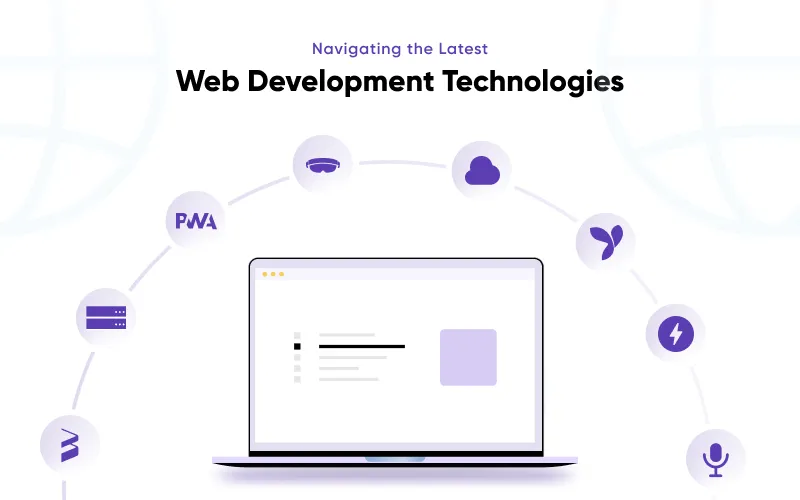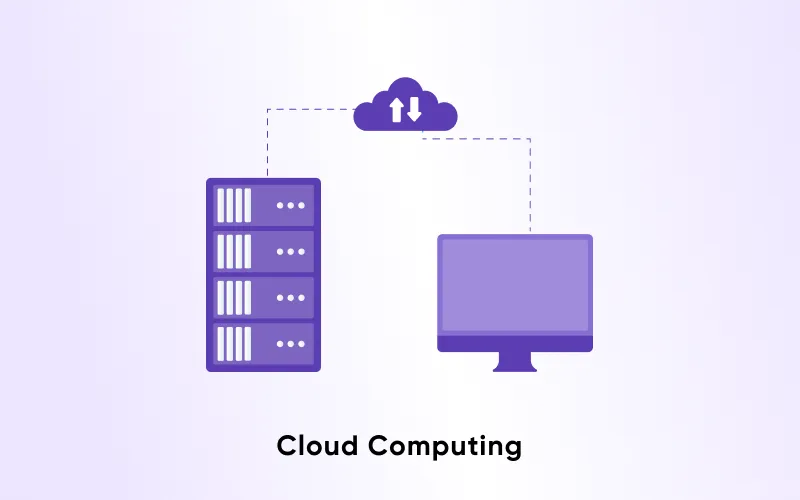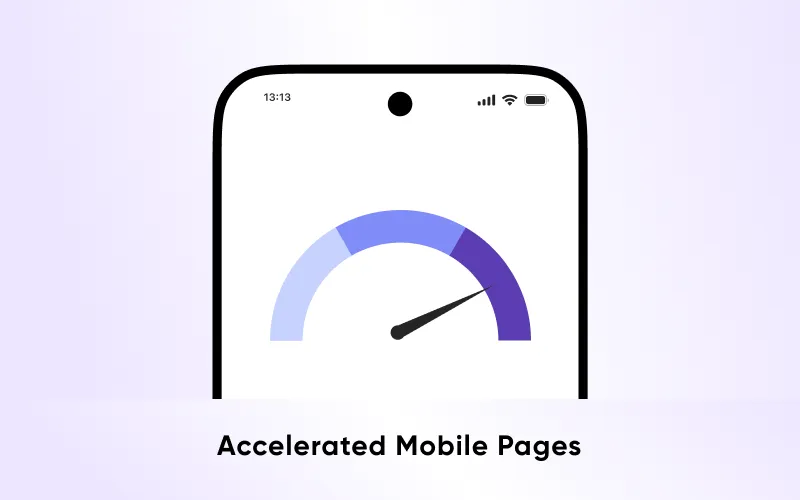Technology


8 min


Web development is an ever-evolving industry demanding constant adaptation from developers. Staying abreast of the latest web technologies is essential, as they directly influence user experience, site speed, and overall performance. As we venture into 2024, it's imperative to familiarize oneself with the prevailing technologies shaping the industry.

By Anupam Singh
16 Feb, 2024
On the first day, 1983, the Internet came to life, marking its official birthday. Picture the digital world taking its first breath, setting the stage for a revolutionary journey that would forever change how we connect, share, and explore. However, in this digital domain, with 1.13 billion websites globally as of February 2023, 82% were deactivated, leaving around 200 million active. In India, we boast 5,708,965 websites.
Here, the question arises? How to keep our website competitive & advanced within the above-listed numbers of websites. So, the solution is to adopt the latest web development technologies to build powerful and viable web solutions.
So, Are you ready to elevate your online presence? Whether starting fresh or amplifying an existing business, leverage the latest web development trends in 2024 to boost engagement and propel your growth.
Apart from this, if you want to take a ride on top web design principles, we have covered this on our blog of the Hackernoon platform.
Digging deep into the latest technology for website development can enhance website performance and ultimately result in business growth. Apart from this, these offer developers a new approach to creating modern and efficient web applications.
Augmented reality (WebAR) is one of the latest web development technologies shaping web solutions in 2024. It integrates digital information, such as images, videos, or 3D models, into the real world. In the context of web application development services, users can experience AR content directly through their web browsers without installing dedicated apps.
Accessibility: By leveraging WebAR, developers can make AR experiences accessible to a broader audience since users don't need to download or install additional apps. They can simply access the AR content through a web browser on their devices, including smartphones, tablets, and desktops.
Cross-platform Compatibility: WebAR is compatible with various devices and platforms, including iOS, Android, and desktop browsers. This cross-platform compatibility ensures that the AR experiences reach users regardless of their device or operating system.
Ease of Distribution: Since WebAR experiences are hosted on the web, distributing and sharing them is straightforward. Developers can easily share links to the AR content via social media, email, or messaging platforms. It allows users to access the experiences with a simple click.
Integration with Web Technologies: WebAR can leverage existing web technologies like HTML, CSS, and JavaScript to create immersive and interactive AR experiences. Developers can integrate AR content seamlessly with other web elements, such as text, images, and videos, to provide a cohesive user experience.
Real-time Updates: Since WebAR experiences are hosted on the web, developers can push real-time updates and improvements to the AR content without requiring users to download. It allows developers to iterate quickly and improve the AR experiences based on user feedback and emerging technologies.
The new technology for web development -WebAR offers a convenient, accessible, and scalable way to deliver immersive AR experiences through web browsers. Nevertheless, it's an attractive option for building web applications with AR capabilities.
 It is one of the latest web development technologies. The pandemic has significantly transformed how businesses operate and people lead their lives.
It is one of the latest web development technologies. The pandemic has significantly transformed how businesses operate and people lead their lives.
Organizations have transitioned to cloud computing due to the growing need for digital interactions. Cloud computing started gaining traction in website development when companies like Amazon Web Services (AWS), Google Cloud Platform (GCP), and Microsoft Azure began offering scalable and flexible infrastructure services over the Internet.
Before cloud computing, website development services often relied on traditional on-premises servers, which required significant upfront investment, maintenance, and manual scaling.
Scalability: Cloud computing services allow developers to scale their applications up or down quickly based on demand. Features like auto-scaling dynamically allocate resources to handle fluctuations in traffic, ensuring optimal performance and cost efficiency.
Flexibility: Cloud platforms offer various services and resources, including virtual machines, databases, storage, and content delivery networks (CDNs). Developers can choose the most suitable services for their requirements, leading to more flexible and customizable solutions.
Cost-effectiveness: Cloud computing operates on a pay-as-you-go model, where users only pay for the resources they consume. It eliminates the need for upfront hardware investment and allows for better cost management by optimizing resource usage.
Reliability and Availability: Cloud providers offer robust infrastructure with built-in redundancy and high availability features. It ensures that web applications remain accessible even during hardware failures or network issues, improving reliability and uptime.
Global Reach: Cloud providers have data centers in various regions worldwide, allowing developers to deploy their applications closer to their users. This reduces latency and improves the overall user experience, particularly for globally distributed applications.
Security: Cloud providers invest heavily in security measures to protect data and applications hosted on their platforms. They offer features like encryption, identity and access management, and compliance certifications to ensure data confidentiality, integrity, and availability.
Cloud computing has transformed website development by offering scalable, flexible, cost-effective, and reliable infrastructure solutions. By leveraging cloud services, developers can build modern web applications capable of handling varying workloads, reaching global audiences, and maintaining high levels of performance and availability.
Serverless architecture, also known as Function as a Service (FaaS), is a cloud computing model where cloud providers dynamically manage the allocation and provisioning of servers to run application code. In a serverless architecture, developers focus solely on writing and deploying code in functions without worrying about managing the underlying infrastructure, such as servers, operating systems, or runtime environments.
Scalability: Cloud providers handle resource scaling, ensuring optimal performance without manual intervention, ideal for fluctuating traffic patterns.
Cost-effectiveness: Developers pay only for function execution time and resources, minimizing costs, particularly unpredictable usage.
Simplified deployment: Serverless platforms abstract infrastructure management, streamlining code deployment, scaling, monitoring, and maintenance.
Faster time to market: Developers focus solely on code, accelerating development and deployment cycles, leading to quicker feature releases and increased agility.
Improved reliability: Cloud providers manage infrastructure, ensuring high availability and fault tolerance. Built-in monitoring and error handling streamline issue resolution.
Microservices architecture: Serverless promotes a modular approach, enhancing flexibility and maintainability. Functions can be developed, deployed, and scaled independently, facilitating seamless integration with other services and APIs.
Interesting Read!- Best Practices of Microservices Architecture
Serverless architecture offers scalability, cost-effectiveness, simplified deployment, faster time to market, improved reliability, and support for microservices, empowering developers to focus on innovation without the burden of traditional server management.
Yii is one of the latest web development technologies. It is a high-performance, component-based PHP framework for developing modern web applications. It follows the model-view-controller (MVC) architectural pattern and provides robust features and tools to streamline development.
Rapid Development: Yii offers scaffolding tools and code generators that automate everyday tasks, such as creating models, controllers, and views. This accelerates the development process and allows developers to focus on implementing business logic rather than boilerplate code.
MVC Architecture: Yii enforces the separation of concerns through the MVC architecture, making it easier to manage code complexity and maintainability. Developers can work on different aspects of the application independently, leading to cleaner and more organized codebases.
Extensibility: Yii is highly extensible, allowing developers to customize and extend its core functionalities through components, modules, and widgets. This flexibility enables developers to integrate third-party libraries, plugins, and extensions seamlessly, expanding the framework's capabilities as needed.
Performance Optimization: Yii is designed with performance in mind, featuring built-in caching mechanisms, lazy loading, and efficient resource utilization. These optimizations help improve the speed and responsiveness of web applications, especially in high-traffic environments.
Security Features: Yii comes with comprehensive security features to protect web applications from common vulnerabilities, such as cross-site scripting (XSS), SQL injection, and cross-site request forgery (CSRF). It provides built-in mechanisms for data validation, authentication, authorization, and secure communication, reducing the risk of security breaches.
Database Access: Yii provides an object-relational mapping (ORM) system called Active Record, simplifying database interactions by mapping database tables to PHP objects. This abstraction layer allows developers to perform CRUD (Create, Read, Update, Delete) operations without writing SQL queries manually, reducing development time and potential errors.
RESTful API Development: Yii offers built-in support for developing RESTful APIs, allowing developers to create web services that follow the REST architectural principles. It is beneficial for building modern web applications with client-server communication, enabling seamless integration with mobile apps, IoT devices, and external services.
In a nutshell, Yii enhances web development solutions by providing a powerful and efficient framework for building secure, scalable, high-performance web applications. Its rich feature set, extensibility, and ease of use make it a popular choice for developers looking to accelerate the development process and deliver robust web solutions.

PWAs are another of the latest web development technologies of the 21st century. A Progressive Web App (PWA) is a web application that leverages modern web technologies to deliver a user experience similar to native mobile apps. PWAs are designed to be fast, reliable, and engaging, and they can work seamlessly across different devices and platforms.
Responsive Design: PWAs are built using responsive design principles, ensuring they look and perform well on various screen sizes and devices, including desktops, smartphones, and tablets.
App-Like Experience: PWAs provide an app-like experience to users, including features like smooth animations, offline functionality, and full-screen mode. It helps engage users and encourages them to interact more with the application.
Service Workers: Service workers are a critical component of PWAs. They are scripts that run in the background and enable features such as offline caching, push notifications, and background synchronization. Service workers allow PWAs to work reliably even when the device is offline, or the network connection is slow or unreliable.
Fast Performance: PWAs are designed to load quickly and provide a smooth user experience. By leveraging techniques such as code splitting, lazy loading, and caching, PWAs minimize loading times and ensure users can access content and functionality without unnecessary delays.
Security: PWAs are served over HTTPS, ensuring secure communication between the web server and the client. This helps protect sensitive user data and ensures the integrity and authenticity of the application.
Discoverability: PWAs are discoverable through web search engines and can be shared via URLs, just like traditional websites. This makes it easy for users to find and access PWAs without the need to install them from an app store.
Cross-Platform Compatibility: PWAs are designed to work across different platforms and devices, including Android, iOS, and desktop operating systems. It makes them a cost-effective solution for reaching a wide audience without developing separate native apps for each platform.
PWAs enhance web app development solutions by providing a modern and user-friendly alternative to traditional web applications and native mobile apps. They combine the best features of both worlds, offering the reach and accessibility of the web with the performance and engagement of native apps. PWAs enable developers to build fast, reliable, and engaging web applications that meet the evolving needs of users and businesses.
One of the latest web development technologies is Web 3.0. It is often called the next generation of the internet, characterized by decentralized, trustless, and interoperable systems. Unlike its predecessors, Web 1.0 (the early, static web) and Web 2.0 (the social, interactive web), Web 3.0 addresses data privacy, security, and ownership issues by leveraging technologies like blockchain, decentralized networks, and cryptographic protocols.
Data Ownership and Privacy: With Web 3.0, users have greater control over their data. Using cryptographic techniques, users can securely manage their identities, digital assets, and personal information without relying on intermediaries. This enhances privacy and enables users to share data with trusted parties selectively, leading to more transparent and equitable data ecosystems.
Smart Contracts: Smart contracts are self-executing contracts with predefined rules and conditions encoded on a blockchain. They enable automated and trustless transactions between parties, eliminating the need for intermediaries and reducing transaction costs. Web 3.0 developers can leverage smart contracts to build decentralized applications that facilitate various use cases, such as decentralized finance (DeFi), supply chain management, and digital identity verification.
Interoperability: Web 3.0 promotes interoperability between blockchain networks and protocols, enabling seamless platform interaction and data exchange. Standards like the Interledger Protocol (ILP) and cross-chain bridges facilitate interoperability, fostering a more connected and inclusive Internet ecosystem. Developers can leverage interoperability to build cross-platform applications that leverage the strengths of multiple blockchain networks and protocols.
Tokenization and Incentive Mechanisms: Web 3.0 introduces tokenization, where digital assets represent ownership rights, access privileges, or utility within decentralized ecosystems. Tokens can incentivize user participation, reward contributions, and align incentives across network participants. Developers can integrate tokenization and incentive mechanisms into web applications to create token-based economies, gamified experiences, and community-driven platforms.
 AMP stands for Accelerated Mobile Pages. It's an open-source framework developed by Google to create faster-loading web pages for mobile devices. It uses a combination of optimized HTML, CSS, and JavaScript to deliver a lightweight and streamlined version of web pages.
AMP stands for Accelerated Mobile Pages. It's an open-source framework developed by Google to create faster-loading web pages for mobile devices. It uses a combination of optimized HTML, CSS, and JavaScript to deliver a lightweight and streamlined version of web pages.
Faster Page Load Times: AMP pages are designed to load almost instantly, providing a better user experience, especially on mobile devices with slower internet connections. Faster page load times can lead to lower bounce rates and higher user engagement.
Improved Search Engine Visibility: Google often prioritizes AMP pages in its search results, especially in mobile searches. By implementing AMP, web apps can benefit from improved visibility and higher search rankings, driving more site traffic.
Enhanced Performance: It enforces strict performance optimizations, such as lazy loading of images and asynchronous loading of resources, to ensure optimal performance on mobile devices. It leads to smoother scrolling and navigation experiences for users.
Better User Experience: AMP restricts heavy JavaScript and third-party scripts, focusing on delivering essential content quickly. It results in a cleaner and more user-friendly interface, reducing distractions and providing a more enjoyable browsing experience.
Increased Accessibility: AMP's emphasis on performance and simplicity makes web apps more accessible to users on various devices and network conditions. It ensures that content is readily available to all users, including those in areas with limited internet connectivity.
Scalability: Since AMP pages are optimized for speed and performance, they are well-suited for large-scale web applications with high traffic volume. AMP's lightweight nature reduces server load and bandwidth requirements, making scaling infrastructure easier as the application grows.
It enables developers to create or build web apps that load quickly, perform well on mobile devices, and rank higher in search results. This, in turn, contributes to providing a superior user experience and building scalable and modern web applications.
One of the latest web development technologies or trends is Optimized Voice Search. It refers to enhancing and fine-tuning a website or web application to effectively respond to voice-based queries from users. As voice-activated devices gain popularity, integrating optimized voice search into web apps boosts scalability and modernity.
Improved User Experience (UX): Voice search offers a more natural and convenient interaction method than traditional text-based searches. Users can simply speak their queries, providing a more intuitive and user-friendly experience.
Accessibility: Optimized voice search enhances accessibility for users with disabilities or those who may find it challenging to use traditional input methods. It ensures a more inclusive experience for a broader audience.
Enhanced Interactivity: Integrating voice search allows users to interact with your web app hands-free. It is advantageous when users can engage in other activities, such as cooking, driving, or exercising.
Time Efficiency: Voice search can be faster than typing, enabling users to get the information they need more quickly. The time efficiency contributes to an improved user satisfaction level.
Scalability: As the number of devices with voice capabilities increases, having an optimized voice search feature can make your web app more scalable. It allows your application to cater to a broader audience and stay relevant as technology evolves. Natural Language Processing (NLP): Optimized voice search often incorporates Natural Language Processing (NLP) capabilities. NLP allows your application to understand and interpret user queries more accurately, improving the overall quality of responses.
Adaptation to Voice-Activated Devices: With the rise of smart speakers, virtual assistants, and other voice-activated devices, integrating optimized voice search ensures your web app remains compatible and functional across various platforms.
To add optimized voice search to your web app, integrate voice recognition, use NLP libraries, and structure content to interpret voice queries accurately. It can involve considering conversational design principles and making your app's content more semantically meaningful for voice interactions.
Adopting the latest technology for website development offers numerous benefits for businesses, including:
New technology for web development often has features that improve the overall user experience, such as faster loading times, smoother animations, and better responsiveness across devices. This can lead to higher user engagement and satisfaction.
The latest web development technologies and tools are optimized for performance, resulting in faster websites and applications. This is crucial for reducing bounce rates and retaining users, especially in today's fast-paced online environment, where users expect instant access to information.
Many new technologies are designed with scalability, allowing businesses to scale their web applications as their user base grows quickly. It ensures that the website or application can handle increased traffic without sacrificing performance or user experience.
With each iteration of new technology for web development, security features are often strengthened to combat evolving cyber threats. Adopting the latest web development technologies can help businesses avoid potential security vulnerabilities and protect sensitive user data.
By leveraging cutting-edge technologies, businesses can differentiate themselves from competitors and attract more customers. A visually appealing and technologically advanced website or application can leave a lasting impression on users and position the business as an industry leader.
While upfront costs may be associated with adopting new technologies, they can lead to cost savings in the long run. Improved performance and scalability can reduce hosting and maintenance expenses, while enhanced user experience can increase conversion rates and revenue.
The latest web development technologies often come with innovative features and functionalities that can be leveraged to create unique and engaging user experiences. By staying up-to-date with the latest trends, businesses can stay relevant and meet the evolving needs of their target audience.
Adopting the latest technology for website development can help businesses stay competitive, attract customers, and drive growth in today's digital landscape. However, it's important for businesses to carefully evaluate their specific needs and goals before deciding which technologies to implement.
Technological advancements are an ever-evolving force striving to streamline and enhance our daily experiences. At the forefront of this technological evolution lies the digital revolution, a transformative era that has particularly favored businesses. Central to this favorability is the rapid emergence of innovative and state-of-the-art or latest web development technologies.
This blog serves as a beacon, illuminating the path to digital success by spotlighting a selection of cutting-edge and new technology for web development. These advancements are optional and imperative for businesses striving to maintain relevance and competitiveness in today's dynamic landscape. Through this exploration, businesses can gain valuable insights and understanding, empowering them to make informed decisions about their digital strategies and technological investments.
To read more blogs like this, follow Quokka Labs, A leading mobile & web development startup company.
How Wearable Technology Is Driving Real-Time Data Experiences in Mobile Apps
By Sannidhya Sharma
5 min read
How to Use Augmented Reality in Retail to Boost Customer Engagement and Sales
By Sannidhya Sharma
5 min read
How to Use Augmented Reality in Accounting to Build Smarter Financial Apps
By Dhruv Joshi
5 min read
Top 10 Enterprise App Development Companies for Scalable Business Solutions
By Dhruv Joshi
7 min read

Technology


5 min
Wearable technology is reshaping mobile apps with real-time insights, enabling smart alerts, fitness coaching, health monitoring, and more. From smart rings to AR glasses, explore how these evolving devices are creating seamless, personalized experiences across various industries and everyday life.


Technology


5 min
Augmented reality in retail helps brands drive sales and reduce returns by transforming how customers discover, try, and buy products. This blog is your guide to using AR strategically, from choosing the right use cases to launching cost-effective AR experiences that delight customers and differentiate your brand.


Technology


5 min
The demand for high-quality video streaming apps has exploded, and it's not just Netflix leading the charge anymore. From niche platforms to corporate media ventures, businesses everywhere are realizing the massive opportunity in OTT app development to launch their own video streaming application.


Feeling lost!! Book a slot and get answers to all your industry-relevant doubts